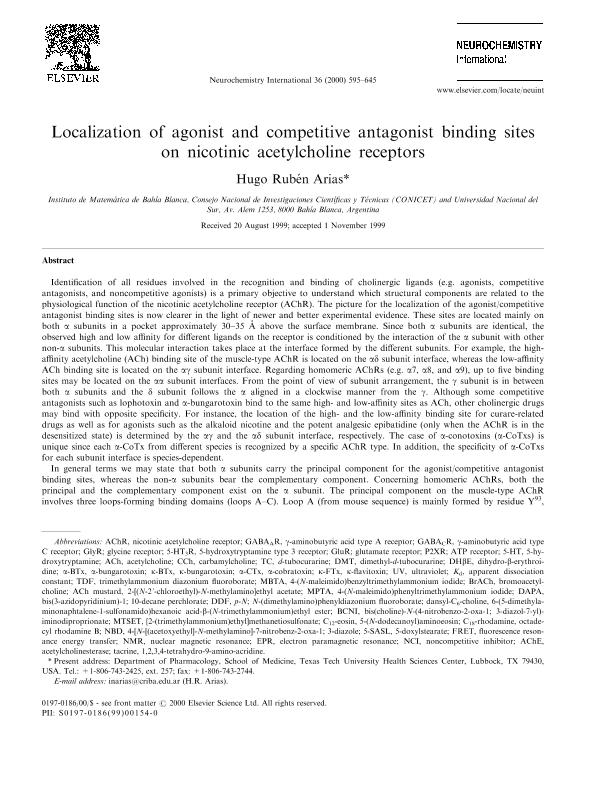Mostrar el registro sencillo del ítem
dc.contributor.author
Arias, Hugo Rubén

dc.date.available
2019-06-14T17:57:07Z
dc.date.issued
2000-06-01
dc.identifier.citation
Arias, Hugo Rubén; Localization of agonist and competitive antagonist binding sites on nicotinic acetylcholine receptors; Pergamon-Elsevier Science Ltd; Neurochemistry International; 36; 7; 1-6-2000; 595-645
dc.identifier.issn
0197-0186
dc.identifier.uri
http://hdl.handle.net/11336/78356
dc.description.abstract
Identification of all residues involved in the recognition and binding of cholinergic ligands (e.g. agonists, competitive antagonists, and noncompetitive agonists) is a primary objective to understand which structural components are related to the physiological function of the nicotinic acetylcholine receptor (AChR). The picture for the localization of the agonist/competitive antagonist binding sites is now clearer in the light of newer and better experimental evidence. These sites are located mainly on both α subunits in a pocket approximately 30-35 A above the surface membrane. Since both α subunits are identical, the observed high and low affinity for different ligands on the receptor is conditioned by the interaction of the α subunit with other non-α subunits. This molecular interaction takes place at the interface formed by the different subunits. For example, the high-affinity acetylcholine (ACh) binding site of the muscle-type AChR is located on the αδ subunit interface, whereas the low-affinity ACh binding site is located on the αγ subunit interface. Regarding homomeric AChRs (e.g. α7, α8, and α9), up to five binding sites may be located on the αα subunit interfaces. From the point of view of subunit arrangement, the γ subunit is in between both α subunits and the δ subunit follows the α aligned in a clockwise manner from the γ. Although some competitive antagonists such as lophotoxin and α-bungarotoxin bind to the same high- and low-affinity sites as ACh, other cholinergic drugs may bind with opposite specificity. For instance, the location of the high- and the low-affinity binding site for curare-related drugs as well as for agonists such as the alkaloid nicotine and the potent analgesic epibatidine (only when the AChR is in the desensitized state) is determined by the αγ and the αδ subunit interface, respectively. The case of α-conotoxins (α-CoTxs) is unique since each α-CoTx from different species is recognized by a specific AChR type. In addition, the specificity of α-CoTxs for each subunit interface is species-dependent.In general terms we may state that both α subunits carry the principal component for the agonist/competitive antagonist binding sites, whereas the non-α subunits bear the complementary component. Concerning homomeric AChRs, both the principal and the complementary component exist on the α subunit. The principal component on the muscle-type AChR involves three loops-forming binding domains (loops A-C). Loop A (from mouse sequence) is mainly formed by residue Y93, loop B is molded by amino acids W149, Y152, and probably G153, while loop C is shaped by residues Y190, C192, C193, and Y198. The complementary component corresponding to each non-α subunit probably contributes with at least four loops. More specifically, the loops at the γ subunit are: loop D which is formed by residue K34, loop E that is designed by W55 and E57, loop F which is built by a stretch of amino acids comprising L109, S111, C115, I116, and Y117, and finally loop G that is shaped by F172 and by the negatively-charged amino acids D174 and E183. The complementary component on the δ subunit, which corresponds to the high-affinity ACh binding site, is formed by homologous loops. Regarding α-neurotoxins, several snake and α-CoTxs bear specific residues that are energetically coupled with their corresponding pairs on the AChR binding site. The principal component for snake α-neurotoxins is located on the residue sequence α1W184-D200, which includes loop C. In addition, amino acid sequence 55-74 from the α1 subunit (which includes loop E), and residues γL119 (close to loop F) and γE176 (close to loop G) at the low-affinity binding site, or δL121 (close to the homologous region of loop G) at the high-affinity binding site, are involved in snake α-neurotoxin binding. The above expounded evidence indicates that each cholinergic molecule binds to specific residues which form overlapping binding sites on the AChR.Monoclonal antibodies have been of fundamental importance in the elucidation of several aspects of the biology of the AChR. Interestingly, certain antibodies partially overlap with the agonist/competitive antagonist binding sites at multiple points of contact. In this regard, a monoclonal antibody directed against the high-affinity ACh binding site (αδ subunit interface) induced a structural change on the AChR where the low-affinity ACh locus (αγ subunit interface) approached to the lipid membrane.The α subunits also carry the binding site for noncompetitive agonists. Noncompetitive agonists such as the acetylcholinesterase inhibitor (-)-physostigmine, the alkaloid galanthamine, and the opioid derivative codeine are molecules that weakly activate the receptor without interacting with the classical agonist binding sites. This binding site was found to be located at K125 in an amphipathic domain of the extracellular portion of the α1 subunit. Interestingly, the neurotransmitter 5-hydroxytryptamine (5-HT) also binds to this site and enhances the agonist-induced ion flux activity. This suggests that 5-HT may act as an endogenous modulator (probably as co-agonist) of neuronal-type AChRs. The enhancement of the agonist-evoked currents elicited by noncompetitive agonists seems to be physiologically more important than their weak agonist properties.
dc.format
application/pdf
dc.language.iso
eng
dc.publisher
Pergamon-Elsevier Science Ltd

dc.rights
info:eu-repo/semantics/openAccess
dc.rights.uri
https://creativecommons.org/licenses/by-nc-nd/2.5/ar/
dc.subject
Nicotinic Acetylcholine Receptor
dc.subject
Agonist Binding Sites
dc.subject
Competitive Antagonist Binding Sites
dc.subject
Pharmacology
dc.subject.classification
Otras Ciencias Biológicas

dc.subject.classification
Ciencias Biológicas

dc.subject.classification
CIENCIAS NATURALES Y EXACTAS

dc.title
Localization of agonist and competitive antagonist binding sites on nicotinic acetylcholine receptors
dc.type
info:eu-repo/semantics/article
dc.type
info:ar-repo/semantics/artículo
dc.type
info:eu-repo/semantics/publishedVersion
dc.date.updated
2019-06-12T14:22:10Z
dc.journal.volume
36
dc.journal.number
7
dc.journal.pagination
595-645
dc.journal.pais
Países Bajos

dc.journal.ciudad
Amsterdam
dc.description.fil
Fil: Arias, Hugo Rubén. Consejo Nacional de Investigaciones Científicas y Técnicas. Centro Científico Tecnológico Conicet - Bahía Blanca. Instituto de Matemática Bahía Blanca. Universidad Nacional del Sur. Departamento de Matemática. Instituto de Matemática Bahía Blanca; Argentina
dc.journal.title
Neurochemistry International

dc.relation.alternativeid
info:eu-repo/semantics/altIdentifier/doi/http://dx.doi.org/10.1016/S0197-0186(99)00154-0
dc.relation.alternativeid
info:eu-repo/semantics/altIdentifier/url/https://www.sciencedirect.com/science/article/pii/S0197018699001540
Archivos asociados
